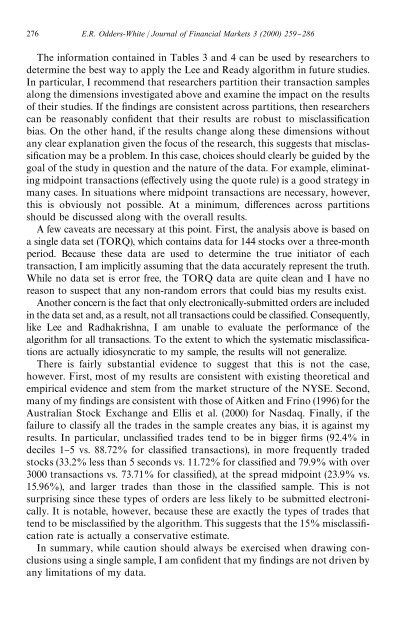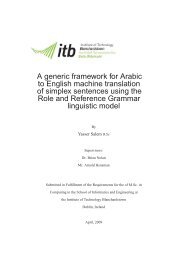On the occurrence and consequences of inaccurate ... - Acsu Buffalo
On the occurrence and consequences of inaccurate ... - Acsu Buffalo
On the occurrence and consequences of inaccurate ... - Acsu Buffalo
You also want an ePaper? Increase the reach of your titles
YUMPU automatically turns print PDFs into web optimized ePapers that Google loves.
276 E.R. Odders-White / Journal <strong>of</strong> Financial Markets 3 (2000) 259}286<br />
The information contained in Tables 3 <strong>and</strong> 4 can be used by researchers to<br />
determine <strong>the</strong> best way to apply <strong>the</strong> Lee <strong>and</strong> Ready algorithm in future studies.<br />
In particular, I recommend that researchers partition <strong>the</strong>ir transaction samples<br />
along <strong>the</strong> dimensions investigated above <strong>and</strong> examine <strong>the</strong> impact on <strong>the</strong> results<br />
<strong>of</strong> <strong>the</strong>ir studies. If <strong>the</strong> "ndings are consistent across partitions, <strong>the</strong>n researchers<br />
can be reasonably con"dent that <strong>the</strong>ir results are robust to misclassi"cation<br />
bias. <strong>On</strong> <strong>the</strong> o<strong>the</strong>r h<strong>and</strong>, if <strong>the</strong> results change along <strong>the</strong>se dimensions without<br />
any clear explanation given <strong>the</strong> focus <strong>of</strong> <strong>the</strong> research, this suggests that misclassi"cation<br />
may be a problem. In this case, choices should clearly be guided by <strong>the</strong><br />
goal <strong>of</strong> <strong>the</strong> study in question <strong>and</strong> <strong>the</strong> nature <strong>of</strong> <strong>the</strong> data. For example, eliminating<br />
midpoint transactions (e!ectively using <strong>the</strong> quote rule) is a good strategy in<br />
many cases. In situations where midpoint transactions are necessary, however,<br />
this is obviously not possible. At a minimum, di!erences across partitions<br />
should be discussed along with <strong>the</strong> overall results.<br />
A few caveats are necessary at this point. First, <strong>the</strong> analysis above is based on<br />
a single data set (TORQ), which contains data for 144 stocks over a three-month<br />
period. Because <strong>the</strong>se data are used to determine <strong>the</strong> true initiator <strong>of</strong> each<br />
transaction, I am implicitly assuming that <strong>the</strong> data accurately represent <strong>the</strong> truth.<br />
While no data set is error free, <strong>the</strong> TORQ data are quite clean <strong>and</strong> I have no<br />
reason to suspect that any non-r<strong>and</strong>om errors that could bias my results exist.<br />
Ano<strong>the</strong>r concern is <strong>the</strong> fact that only electronically-submitted orders are included<br />
in <strong>the</strong> data set <strong>and</strong>, as a result, not all transactions could be classi"ed. Consequently,<br />
like Lee <strong>and</strong> Radhakrishna, I am unable to evaluate <strong>the</strong> performance <strong>of</strong> <strong>the</strong><br />
algorithm for all transactions. To <strong>the</strong> extent to which <strong>the</strong> systematic misclassi"cations<br />
are actually idiosyncratic to my sample, <strong>the</strong> results will not generalize.<br />
There is fairly substantial evidence to suggest that this is not <strong>the</strong> case,<br />
however. First, most <strong>of</strong> my results are consistent with existing <strong>the</strong>oretical <strong>and</strong><br />
empirical evidence <strong>and</strong> stem from <strong>the</strong> market structure <strong>of</strong> <strong>the</strong> NYSE. Second,<br />
many <strong>of</strong> my "ndings are consistent with those <strong>of</strong> Aitken <strong>and</strong> Frino (1996) for <strong>the</strong><br />
Australian Stock Exchange <strong>and</strong> Ellis et al. (2000) for Nasdaq. Finally, if <strong>the</strong><br />
failure to classify all <strong>the</strong> trades in <strong>the</strong> sample creates any bias, it is against my<br />
results. In particular, unclassi"ed trades tend to be in bigger "rms (92.4% in<br />
deciles 1}5 vs. 88.72% for classi"ed transactions), in more frequently traded<br />
stocks (33.2% less than 5 seconds vs. 11.72% for classi"ed <strong>and</strong> 79.9% with over<br />
3000 transactions vs. 73.71% for classi"ed), at <strong>the</strong> spread midpoint (23.9% vs.<br />
15.96%), <strong>and</strong> larger trades than those in <strong>the</strong> classi"ed sample. This is not<br />
surprising since <strong>the</strong>se types <strong>of</strong> orders are less likely to be submitted electronically.<br />
It is notable, however, because <strong>the</strong>se are exactly <strong>the</strong> types <strong>of</strong> trades that<br />
tend to be misclassi"ed by <strong>the</strong> algorithm. This suggests that <strong>the</strong> 15% misclassi"cation<br />
rate is actually a conservative estimate.<br />
In summary, while caution should always be exercised when drawing conclusions<br />
using a single sample, I am con"dent that my "ndings are not driven by<br />
any limitations <strong>of</strong> my data.
















